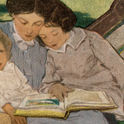It’s no secret that Salvador Dalí had a kink for death.
“Dead faces, skulls, corpses of animals occur fairly frequently in his pictures, and the ants which devoured the dying bat make countless reappearances. One photograph shows an exhumed corpse, far gone in decomposition. Another shows the dead donkeys putrefying on top of grand pianos which formed part of the Surrealist film, Le Chien Andalou.”
So writes George Orwell, with upturned nose, in his essay, “Benefit of Clergy: Some Notes on Salvador Dala famous take-down of Dalí’s bloviated, incendiary, genre-busting autobiography The Secret Life of Salvador Dalí, in which the artist takes great pleasure casting himself as an antihero.
Orwell was nauseated by Dalí’s exuberant embrace of the grotesque, and he wasn’t exaggerating in his description of The Secret Life as “a strip-tease act conducted in pink limelight.” The book romps through Dalí’s addiction to provocation, particularly when it comes to describing his fixation with masturbation and his disinterest in actual sex. Dalí delights in his own necrophagic obsessions, dwelling on the possibility of eating decayed flesh—an interest he also classifies as perverse, but tameable. He then demonstrates his so-called controlled appetite by recounting a story of a king who cures his erotic obsession with death by consuming a female mannequin’s sugar nose—a stand-in for the king’s desire to consume a real woman.
After he symbolically “kills” her, he finds ecstasy in the sweetness of death, but also in the sweetness of life. He then immediately regrets the act of killing her—she would have been just as sweet living, he determines. Sacre bleu! What a realisation.
This tale is also meant as an allegory about Dalí’s marriage to his wife, Gala—a woman who, by all accounts, had as much flair for drama and cruelty as Dalí himself. He was deeply committed to her, sex aside. She was equally enraptured by her husband, his work, and his money—fulfilling her desire for sex elsewhere.
For Orwell, it is exactly Dalí’s braggadocio about such things that make his autobiography odious. “It is a book that stinks.” Orwell insisted. “If it were possible for a book to give a physical stink off its pages, this one would—a thought that might please Dalí, who before wooing his future wife for the first time rubbed himself all over with an ointment made of goat's dung boiled up in fish glue.”
It is always a boondoggle to try and guess what a non-living person would think of something unless they’ve left explicit directions or opinions. Orwell, though, is probably right: Dalí would likely have delighted in his book having turn-and-sniff pages which give off the scent of rotting garbage.
But to wonder what Dalí would have thought of what happens to him after death is an entirely more intimate and problematic question.
Upon the recent news that a Spanish judge has ordered Dalí’s body exhumed in order to procure a DNA sample for a paternity test, it’s easy, and only natural, to guess that Dalí would have been delighted. His penchant for exhumation suggests as much.
But of course, it’s more complicated than that. For Dalí did leave directives about what to do with his body—and they did not include anything about being dug up. On the contrary, he is more entombed than most, resting in a marble catacomb under a formidable crystal geodesic dome. In current pictures, there is a large statue of a giraffe looking down on his and Gala’s resting places.
So where is the line with this kind of inquest? Can anyone get a body dug up in this manner? Do we care about what the dead might wish?
And should the line be drawn differently for those who loved spectacle?
Dalí pursued attention, demanded it, in all directions, in all aspects of his life. In 1941, he threw a famous, decadent “Night in a Surreal Forrest” party in Monterey, under the auspices of it being a fundraiser for refugee artists who had to flee to America during the war. He said, “Gala and I were fortunate to leave France when we did, but the other artists were not so lucky. Now that some have come to America they are in financial need. No one thinks of the artists. They are forgotten. That must not be. Dalí will assist them.”
But there’s no doubting that his true interest was in the spectacle. As he also said of the plans: “We shall startle everyone.” Imagine making shock the goal of a refugee fundraiser today. At the very least, such a fête would have been destroyed on social media. (A 2017 Dalí would almost certainly love causing that kind of reaction.)
Yet the exhumation is not intended to shock or be surreal, even if it is both. Instead, the intent is related to deeply intimate matters of Dalí’s body, pieces of which are to be extracted and analysed for a DNA sequence that might reveal information which has long been secreted by death. Would Dalí be appalled that the reason was to determine if he was a father, when he took such delight in declaring a disinterest in sex?
There is a lot at stake for Dalí’s afterlife if he proves to be a father. He would no longer be known how he wanted to be known, or how he wrote himself. But there is even more at stake for Pilar Abel, the Spanish woman and tarot card reader who claims that she was told by her mother—now suffering from Alzheimer’s—that she was Dalí’s daughter. English publications have described Abel as a psychic, fortune teller, and tarot card reader—but Spanish publications call her pythonisa or “pythoness,” a kind of female soothsayer or oracular priestess.
***
The soothsayer sees her face in Dalí. She said in a television interview she just wants to know her identity. If she discovers she is his daughter, she will be entitled to a quarter of the massive Dalí fortune. Many of the newspaper reports point out that she has been litigious in the past, suing and losing a claim that the writer Javier Cercas libelled her in his novel, Soldiers of Salamina, by portraying her as a character called 'Conchi.' Maybe she is only out for attention as well. Maybe her need for attention is real, and her desire to know who her real father is also real. Still, it is unsettling that a body could be exhumed to feed someone’s sense of spectacle—even Dalí’s. Even if we suppose he would have been thrilled.
There is a story Dalí proudly recounts in The Secret Life—that Orwell also condemns—about a young girl who loved Dalí so much that she followed him for five years while he led her on, getting off on the agony of her unfulfilled desire and unrequited love. There is another story he tells about a woman who has taken a fancy to him: he watches her flirtation calculatedly, and then kicks her brutally to punish her. He is 29 years old, and courting his future wife.
Abel claims her mother met Dalí when she was a 25-year-old maid in Port Lligat, Spain and he was 55. It all sounds unlikely. What reason would Dalí, so wedded to unconsummated love that he played the music from Wagner’s Tristan and Isolde as he was dying, have for such an affair? Is it possible Dalí had sex not to pleasure himself, but to torture someone else? To torture Gala? If you take his account of himself as true, that is perhaps the only fitting explanation.
But as Orwell points out, one can’t take him at his word. His pomposity is so extreme, and stories so preposterous, that they can’t be taken at face value. What emerges is only his desire to shock.
A Dalí daughter would shock. Momentarily.
***
The larger picture of the Dalí exhumation is what kind of shock we as a society want to invest in and are prepared to accept. The world lately feels on the verge of, or already entering, a kind of an elongated identity crisis and nightmare. We are carrying around a heavy shared anxiety tied to our collective sense of our troubling future.
Do we reject the grotesque, as Orwell, writing from similarly fraught times, pleads for us to do? Or do we embrace that we are living in it, that we are all Dalí and the soothsayer right now—that we, perhaps, are all exhibitionists seeking attention for our own personal truths, instead of community members trying to find common ground? Are we going to reckon with our decadence and our ability to destroy and admit we hurt beating hearts in selfishness and greed while we shrug our shoulders and watch? When will we start to slow the widening gyre with our own able hands and the tools we know how to use? Or are we too captivated by the splitting seams of morality?
The Dalí Foundation is appealing the judge’s order—they don’t think Dalí would have wanted this.
Whatever. Dig him up! It’ll be a spectacle! Let us see ourselves as the voyeurs we are, and then maybe we’ll both gasp and grasp at the truth. Maybe we’ll be disappointed in its mundanity. Maybe we’ll start to ask ourselves harder questions about who we are and what we’re gawking at and tweeting about, and what we’re failing to connect and fix and mend. Or maybe not. It doesn’t matter anyway—Dalí won’t feel a thing. This is something we are getting very good at, as well: not feeling anything at all. Perhaps we can ask the soothsayer how to exhume our feelings for us, too.













